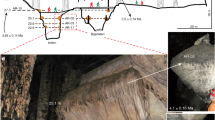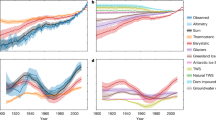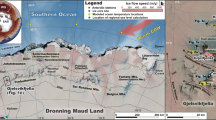Abstract
The melting of mountain glaciers and ice caps is expected to contribute significantly to sea-level rise in the twenty-first century1,2,3, although the magnitude of this contribution is not fully constrained. Glaciers in the Patagonian Icefields of South America are thought to have contributed about 10% of the total sea-level rise attributable to mountain glaciers in the past 50 years3. However, it is unclear whether recent rates of glacier recession in Patagonia are unusual relative to the past few centuries. Here we reconstruct the recession of these glaciers using remote sensing and field determinations of trimline and terminal moraine location. We estimate that the North Patagonian Icefield has lost 103±20.7 km3 of ice since its late Holocene peak extent in ad 1870 and that the South Patagonian Icefield has lost 503±101.1 km3 since its peak in ad 1650. This equates to a sea-level contribution of 0.0018±0.0004 mm yr−1 since 1870 from the north and 0.0034±0.0007 mm yr−1 since 1650 from the south. The centennial rates of sea-level contribution we derive are one order of magnitude lower than estimates of melting over the past 50 years3, even when we account for possible thinning above the trimline. We conclude that the melt rate and sea-level contribution of the Patagonian Icefields increased markedly in the twentieth century.
This is a preview of subscription content, access via your institution
Access options
Subscribe to this journal
Receive 12 print issues and online access
$259.00 per year
only $21.58 per issue
Buy this article
- Purchase on Springer Link
- Instant access to full article PDF
Prices may be subject to local taxes which are calculated during checkout



Similar content being viewed by others
References
Raper, S. C. B. & Braithwaite, R. J. Low sea level rise projections from mountain glaciers and icecaps under global warming. Nature 439, 311–313 (2006).
Meier, M. F. et al. Glaciers dominate eustatic sea-level rise in the twenty first century. Science 317, 1064–1067 (2007).
Rignot, E., Rivera, A. & Casassa, G. Contribution of the Patagonia Icefields of South America to sea level rise. Science 302, 434–437 (2003).
Meier, M. F. Contribution of small glaciers to global sea level. Science 226, 1418–1421 (1984).
Rosenblüth, B. et al. Recent temperature variations in Southern South America. Int. J. Climatol. 17, 67–85 (1997).
Aniya, M. Glacier inventory for the Northern Patagonian Icefield, Chile, and variations 1944/5 to 1985/86. Arct. Alp. Res. 18, 307–316 (1988).
Oerlemans, J. & Fortuin, J. P. E. Sensitivity of glaciers and small ice caps to greenhouse warming. Science 258, 115–117 (1992).
Church, J. A. & White, N. J. A twentieth century acceleration in global sea-level rise. Geophys. Res. Lett. 33, L01602 (2006).
Braithwaite, R. J. & Raper, S. C. B. Glaciers and their contribution to sea level change. Phys. Chem. Earth 27, 1445–1454 (2002).
IPCC Climate Change 2007: The Physical Science Basis (eds Soloman, S., et al.) 418 (Cambridge Univ. Press, 2007).
Oerlemans, J., Dyurgerov, M. & van de Wal, R. S. W. Reconstructing the glacier contribution to sea-level rise back to 1850. Cryosphere 1, 77–97 (2007).
Miller, L. & Douglas, B. C. Mass and volume contributions to twentieth-century global sea level rise. Nature 428, 406–409 (2004).
Haakensen, N. Glacier mapping to confirm results from mass-balance measurements. Ann. Glaciol. 8, 73–77 (1986).
Maisch, M. The long-term signal of climate change in the Swiss Alps: Glacier retreat since the end of the Little Ice Age and future ice decay scenarios. Geogr. Fis. Dinam. Quat. 23, 139–151 (2000).
Harrison, S., Winchester, V. & Glasser, N. F. The timing and nature of recession of outlet glaciers of Hielo Patagónico Norte, Chile, from their Neoglacial IV (Little Ice Age) maximum positions. Glob. Planet. Change 59, 67–78 (2007).
Winchester, V et al. Recent retreat Glaciar Nef, Chilean Patagonia, dated by lichenometry and dendrochronology. Arct. Antarct. Alp. Res. 33, 266–273 (2001).
Masiokas, M. H. et al. Glacier fluctuations in extratropical South America during the past 1000 years. Palaeogeogr. Palaeoclimatol. Palaeoecol. 281, 242–268 (2009).
Rivera, A. et al. Use of remotely sensed and field data to estimate the contribution of Chilean glaciers to eustatic sea-level rise. Ann. Glaciol. 34, 367–372 (2002).
Chen, J. L. et al. Patagonia Icefield melting observed by Gravity Recovery and Climate Experiment (GRACE). Geophys. Res. Lett. 34, L22501 (2007).
Rivera, A. et al. Ice elevation changes of Glaciar Chico, southern Patagonia, using ASTER DEMs, aerial photographs and GPS data. J. Glaciol. 51, 105–112 (2005).
Arendt, A. A. et al. Rapid wastage of Alaska Glaciers and their contribution to rising sea level. Science 297, 382–386 (2002).
Oerlemans, J. Extracting a climate signal from 169 glacier records. Science 308, 675–677 (2005).
Berthier, E. et al. Contribution of Alaskan glaciers to sea-level rise derived from satellite imagery. Nature Geosci. 3, 92–95 (2010).
Larsen, C. F. et al. Glacier changes in southeast Alaska and northwest British Columbia and contribution to sea level rise. J. Geophys. Res. 112, F01007 (2007).
Vaughan, D. G. Recent Trends in Melting Conditions on the Antarctic Peninsula and their implications for ice-sheet mass balance and sea level. Arct. Antarct. Alp. Res. 38, 147–152 (2007) 2007.
Dyurgerov, M. B. & Meier, M. F. Year-to-year fluctuations of global mass balance of small glaciers and their contribution to sea-level changes. Arct. Antarct. Alp. Res. 29, 392–402 (1997).
Zuo, Z. & Oerlemans, J. Contribution of glacier melt to sea-level rise since ad 1865: A regionally differentiated calculation. Clim. Dyn. 13, 835–845 (1997).
Kaser, G. et al. Mass balance of glaciers and ice caps: Consensus estimates for 1961–2004. Geophys. Res. Lett. 33, L19501 (2006).
Hagen, J. O. et al. On the net mass balance of the glaciers and ice caps in Svalbard, Norwegian Arctic. Arct. Antarct. Alp. Res. 35, 264–270 (2003).
Cabanes, C., Cazenave, A. & Le Provost, C. Sea level rise during past 40 years determined from satellite and in situ observations. Science 294, 840–842 (2001).
Acknowledgements
The UK Natural Environment Research Council (NERC) and the Leverhulme Trust supported this work financially. NASA provided ‘No Cost’ access to the ASTER imagery used to map former LIA glacier extent. ASTER GDEM is a product of METI and NASA and is available at no charge to users worldwide via electronic download from ERSDAC and LP DAAC respectively.
Author information
Authors and Affiliations
Contributions
N.F.G. performed the geomorphological mapping and contemporary glacier mapping and wrote the manuscript, S.H. contributed the original idea for this work, initiated the program of dating LIA moraines in Patagonia and helped with manuscript writing, K.N.J. helped with remote sensing and geomorphological mapping, K.A. advised on GIS analysis methods and A.C. undertook the computational modelling and scripting work using Arc-GIS, Python and Excel. N.F.G., S.H. and K.N.J. all took part in fieldwork in Patagonia.
Corresponding author
Ethics declarations
Competing interests
The authors declare no competing financial interests.
Supplementary information
Supplementary Information
Supplementary Information (PDF 1088 kb)
Rights and permissions
About this article
Cite this article
Glasser, N., Harrison, S., Jansson, K. et al. Global sea-level contribution from the Patagonian Icefields since the Little Ice Age maximum. Nature Geosci 4, 303–307 (2011). https://doi.org/10.1038/ngeo1122
Received:
Accepted:
Published:
Issue Date:
DOI: https://doi.org/10.1038/ngeo1122
This article is cited by
-
Accelerated mass loss of Himalayan glaciers since the Little Ice Age
Scientific Reports (2021)
-
Projected increases in surface melt and ice loss for the Northern and Southern Patagonian Icefields
Scientific Reports (2021)
-
Ice thickness and volume changes across the Southern Alps, New Zealand, from the little ice age to present
Scientific Reports (2020)
-
Two decades of glacier mass loss along the Andes
Nature Geoscience (2019)
-
Hydrographic and Biological Impacts of a Glacial Lake Outburst Flood (GLOF) in a Patagonian Fjord
Estuaries and Coasts (2019)



